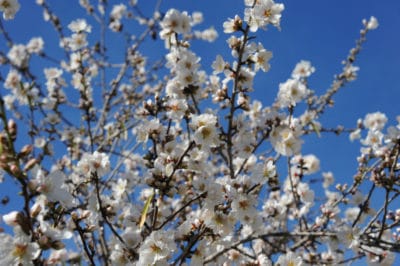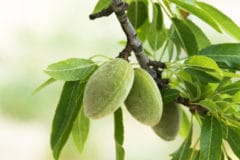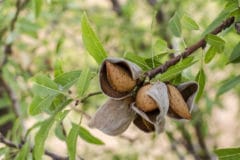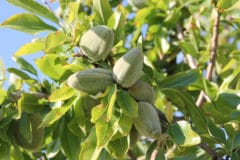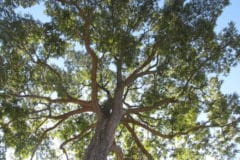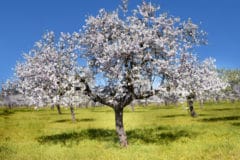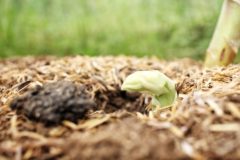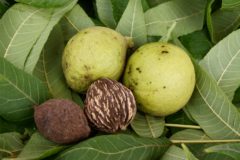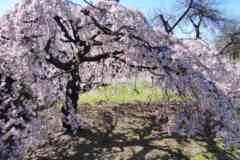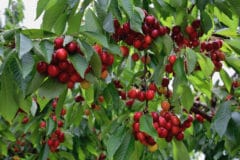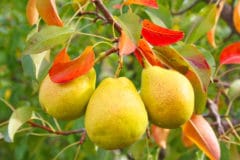Flowering Almond Varieties
Whether you’re working with a large yard or small, sunny border, there’s a flowering almond variety to suit your needs:
- The smallest is the dwarf flowering almond (Prunus glandulosa ‘Sinensis’). Faithful pruning maintains it at 3 feet high and 4 feet wide. Its ¾-inch, double blooms could easily pass for miniature carnations. ‘Sinensis,’ also known as ‘Rosea Plena,’ is hardy to zone 4 and -30°F (-34.4°C).
- For larger gardens, there are the flowering almond bushes (Prunus triloba ‘Multiplex,’ Prunus triloba ‘Simplex), which many gardeners shape as small trees. They grow in zones 3 through 7 and tolerate cold down to -40°F (-37.2°C) In USDA zone 3. Both reach 12 feet high and wide. ‘Multiplex’ features double pink flowers; ‘Simplex’ boasts five-petaled, single blooms.
How to Use Flowering Almonds
There’s no way around it: flowering almonds are meant to share their spring displays with the world. Plant one as a front-yard border accent. or several along a walkway interspersed with later-blooming shrubs. Once their flowers die back, flowering almonds don’t provide much color until their leaves turn in fall.
Expert gardener’s tips:
- To double their spring impact, position flowering almonds against a backdrop of darker evergreens.
- Although no flowering almond produces harvestable nuts, ‘Simplex’ has red summer berries irresitible to birds and squirrels.
The Planting Site
Flowering almonds bloom most heavily where they get six or more hours of daily sun. They’ll flower in partial shade, but with much less vigor. Loose, well-draining loamy soil is ideal.
Where Not to Plant
Fragile bark makes flowering almonds poor candidates for any site within 4 to 6 feet of any site that needs regular mowing. They’re intolerant of salt air, so coastal areas are a problem. And never plant one where water might puddle around its roots. Doing so invites root rot.
Space Matters
Choose a spot large enough to allow at least 1 foot between your fully grown flowering almond and the surrounding plants or structures. For example, allow 3 feet of space between dwarf ‘Sinensis,’ which reaches 4 feet wide, and other plants or objects. For ‘Simplex’ or ‘Multiplex,’ which get up to 12 feet wide, increase the spacing to 7 feet.
When to Plant
If possible, plant your flowering almond shrub after your first fall frost. This applies whether it’s container grown or balled and burlapped. Fall planting allows the shrub to channel energy to root growth instead of putting out shoots and leaves. The second-best planting time is after your last spring frost.
Preparing the Site
Before planting, amend your soil with organic compost. Doing so improves drainage and enriches the soil with a slow, steady stream of nutrients.
To determine how much compost you need, multiply your site’s length and width to find its square footage. Divide the answer by 162. The resulting number is the cubic feet of compost you need for a 2-inch layer.
Adding the Compost
Rake the compost layer evenly over the planting area and use a rotary tiller to work it into the top 10 inches of soil. Make sure it’s thoroughly mixed; otherwise, your almond’s roots may be content to stay in their planting hole instead of expanding deeper into the soil.
Planting Your Flowering Almond
For planting, you’ll need a dirt shovel, a 1-gallon (3.7-liter) container, water and (if the plant is balled and burlapped} scissors or wire cutters:
- Choose a cool, cloudy day for planting. This minimizes heat stress on your plant. Dig a hole the same depth and twice the width of the rootball.
- Slide the flowering almond carefully from its container. If it’s balled and burlapped, cut the burlap’s wire or twine and pull the material burlap away the rootball’s top and sides.
- Center the flowering almond in base of the hole; spread the burlap out but leave it in contact with the rootball’s bottom. Over time, it will decompose.
- Start refilling the hole with soil, tamping down gently as you work to eliminate air pockets. At the halfway mark, slowly add 1 to 2 gallons (3.8 to 7.6 liters) of water over the roots. Let the soil settle.
- Add more soil until the rootball is covered.
- Give the flowering almond another 2 to 3 gallons (7.6 to 11.4 liters) of water.
- Encircle the hole with a mound of leftover soil. It steers water to the roots.
Watering
During its first year, your flowering almond needs consistently moist soil. The trick is to keep it moist but never saturated.
When to Water
Before watering, insert a finger into the rootball. If it’s noticeably wet, hold off on watering.
How to Water
Like all almonds, these ornamentals do best with slow, deep watering. For an economical drip-system or soaker-hose alternative, poke drainage holes in the base of a plastic 5-gallon (19 liter) paint bucket. Set it next to your plant and fill it halfway whenever the roots feel dry.
Expert gardener’s tip: During the first two or three years after planting, water your flowering almond well before the ground freezes in fall. Once it’s mature, do this only during drought.
Feeding
To keep your flowering almond at its happiest, healthiest best, fertilize it in early spring and early fall. An organic, slow-release balanced fertilizer (one with equal N-P-K numbers on its label) is best.
How to Fertilize
Fertilize on a calm day when the soil is damp. Apply the granules evenly over the soil at the manufacturer’s recommended rate. Starting a few inches from the base of your tree or shrub, scatter them to the tips of the branches, or drip line. Then water thoroughly to prevent root burn.
Pruning
Regular pruning keeps your flowering almond vigorous and tidy. Because it blooms on old wood, the ideal time to prune is in spring right after its flowers fade. You can also prune during winter dormancy, but doing so diminishes the next spring’s display.
How to Prune
- Sterilize your branch pruners by rinsing them in rubbing alcohol for 30 seconds before getting to work.
- Remove any dead, damaged, diseased or insect-riddled branches.
- Trim back up rubbing and crossed branches.
- Stand back and study your bush or tree. Decide which healthy the branches you can prune while still keeping its form balanced. The goal is to remove about one-third of the new growth.
- Cut the new growth directly above lateral branches or buds at an upward, 45-degree angle.
Flowering Almond Problems
Flowering almonds face several potentially life-shortening problems. The most serious is fire blight, which causes new shoots to wilt and blacken in late spring. Insects spread it from infected pear, apple and quince trees. During dormancy, prune the diseased branches at least 3 inches below the damage and dispose of them in the trash.
Other Problems
Yellowish-white flatheaded borer larvae tunnel into — and eventually girdle — the trunk, weakening the entire plant. An infested flowering almond oozes white, foamy sap. To keep borers out, wrap the trunk with horticultural tree wrap from your garden store.
Powdery mildew coats the leaves with grayish-to-white fungal spores. It’s most active in damp, humid weather. To prevent an outbreak, mix 1 tablespoon (14.8 ml) of baking soda and 1/2 teaspoon (2.5 ml) of liquid hand soap in 1 gallon (3.8 liters) of water. Spray the plant to the dripping point every 10 days to two weeks until the weather changes.
Aphids and Scale Insects
Pear-shaped aphids and waxy, doomed scale insects both colonize flowering almond stems and leaves to drain sap with their syringelike mouths. They also excrete honeydew, a sticky waste that attracts ants and greasy sooty mold. At the first sign of infestation, hit the pests with a strong blast from the garden hose.
What to Expect
While susceptibility to pests and disease may limit your flowering almond’s lifespan to less than 10 years, consistent TLC can extend it much longer!
